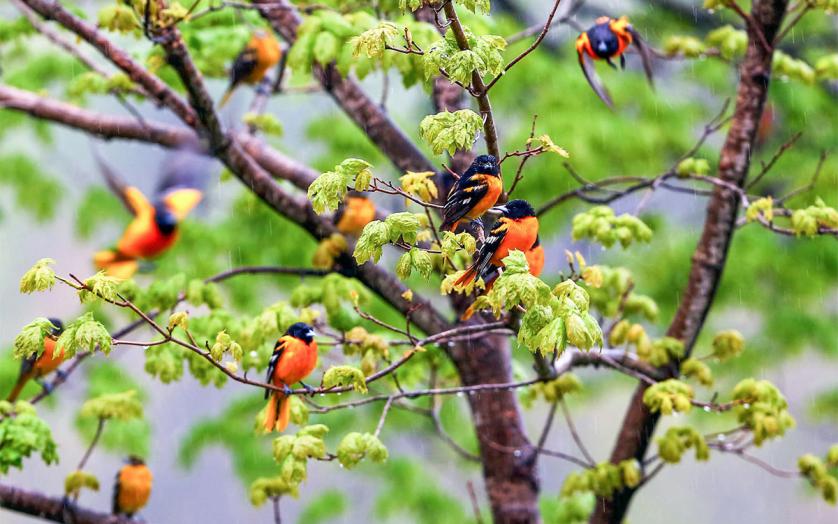
Top 10 Maryland Birding Experiences
When making travel plans, many birders and wildlife watchers seek spectacular shows of animal behavior. Maryland’s wild areas set the stage for many dramatic avian displays, and each season delivers its own untamed theater of bird migration, courtship, nesting, and winter survival.
Thanks to thousands of acres of Maryland lands protected and managed for wildlife, and to the bountiful waters of the Chesapeake Bay, coastal bays, and the Atlantic Ocean, our birds have much of the habitat they need for their annual rituals.
We’ve chosen 10 of the greatest Maryland birding experiences and grouped them by season, along with some of the best places for you to witness these stunning spectacles. Grab your binoculars, scopes and cameras to explore Maryland and witness these fascinating feathered phenomena for yourself!

If there's one wildlife experience that defines Chesapeake Country in the winter, it may be the annual arrival of migrating Snow Geese to our coastal marshes and farm fields.
In late November, hundreds of thousands of Snow Geese migrate to Maryland’s Eastern Shore from summer breeding grounds in the Arctic. If you're in the right spot to witness their arrival, you may think there is an ominous snow shower looming in the distance. As they approach, geese migrating in crisp V-shapes morph into snaking, shifting U-formations as they prepare for landing. Massive flocks can temporarily block out the sun.
As they get closer, thousands of geese create a cresting wave of squawks and honks. The noise builds until you can't hear anything else around you. The deafening chorus can create a ringing in your ears that will take you hours to shake loose. They float to the ground from higher altitudes in layer after layer of white, tumbling geese. As they make landfall, they begin to cover the ground, first in just a few patches here and there, but before you know it, the field or marsh is blanketed in a flock of mostly white geese.
As impressive as witnessing the arrival of thousands of Snow Geese, watching them explode in unison into a liftoff flight is equally thrilling. Seemingly without warning, the feeding flock will burst into the air, with the sound of beating wings and squawking beaks merging into one deafening wall of sound. The experience can take your breath away.
Suggested viewing locations: Blackwater National Wildlife Refuge, Pickering Creek Audubon Center, Eastern Neck National Wildlife Refuge

The recovery of the Bald Eagle is one of the greatest conservation success stories in North America. Maryland served a major role in the comeback of this formerly endangered species. Today, the Free State is one of the best places to view Bald Eagles now that our national symbol is back from the brink of extinction.
You'll find Bald Eagles soaring and hunting over our coastal marshes, or resting in tall trees near the water. Mature birds look distinguished with their white head and tail feathers at the terminal ends of their dark chocolate-brown bodies. Young birds are mostly dark brown until they are four to five years old.
Bald Eagles mate for life, and their preferred nesting sites are the tops of the tallest pine trees. Nests made of sticks and marsh grass are added to each year, and may reach 10 feet across and weigh more than a ton. Bald Eagles are one of Maryland's earliest nesters, and they will typically lay one to three eggs as early as late January.
The Bald Eagle faced serious threats to its survival shortly after World War II. Eagles and other wild birds came seriously close to extinction when they began eating prey contaminated with dichlorodiphenyltrichloroethane, more commonly known as DDT. The harmful pesticide caused eggshells of eagles and other birds to become very thin, causing the eggs to break during incubation.
Very few Bald Eagles were hatched during the decades when DDT was in use, and populations plummeted from around 100,000 nesting pairs in the 1800s to fewer than 400 in the 1960s. DDT was eventually banned in 1972, and the Bald Eagle was declared an endangered species in 1978. Breeding Bald Eagles, including those pairs living in Maryland around Blackwater National Wildlife Refuge, started raising healthy young eaglets, and the species began to recover. By 1995, the Bald Eagle's federal status was changed from endangered to threatened. In 2007, it was removed completely from the federal Endangered Species List, thanks in large part to eagle conservation efforts right here in Maryland.
Today, we can find Bald Eagles in all regions of Maryland, and they can be seen year-round. Early winter is a great time to see them before they pair off to begin nesting. One of the best places on the East Coast to view large gatherings of Bald Eagles is the Conowingo Dam on the Susquehanna River in Darlington, MD, where dozens of eagles compete with each other for fish near the base of the dam.
Suggested viewing locations: Blackwater National Wildlife Refuge, Fisherman’s Park at Conowingo Dam, Point Lookout State Park and the Port Tobacco River Park Eagle-Cam, whose resident eagle family can also be seen on camera.
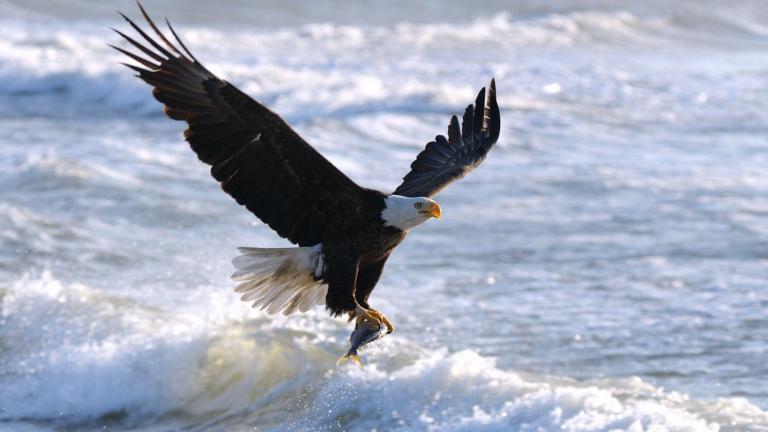
There's nothing quite like a sunrise waking up the waterfowl on a Maryland lake, river or inlet on a crisp winter morning. As the sun peeps over the horizon, gently warming the frozen landscape and melting away the frost, the waterfowl begin their noisy morning ritual.
In fresh and brackish water, elegant Northern Pintails and tiny Green-winged Teal dabble on the water's surface near the shore. Nearby, elegant, snow-white Tundra Swans bugle and hoot, tipping up in the shallow water to feed on underwater grasses below. In the deeper water, Canvasbacks and Ruddy Ducks dip and dive to the bottom for breakfast. A flock of Black Ducks breaks your trance with an explosive, quacking liftoff as a Bald Eagle hunts overhead.
At the Ocean City inlet, thick-bodied scoters, eiders and Harlequin Ducks dive to glean algae and mussels from the rocks on the jetty. Long-tailed Ducks bob and dive in the near-shore waves. Rafts of cackling Brant forage across the inlet at the northern tip of Assateague Island.
More than 30 different species of Atlantic Flyway waterfowl winter in Maryland. They usually arrive in great numbers when the northern regions are covered in ice and snow, which makes for difficult feeding conditions. Millions of birds depend upon Maryland’s wetlands, shallow open waters and nearby fields for survival. Only a few species of wild waterfowl breed in the Free State, as most migrate north in the spring to nest and raise young.
Maryland's waterfowl range in size from tiny Green-winged Teal and Ruddy Ducks, both around 15 inches long and one pound in weight, to the enormous Trumpeter Swan, which stretches more than 5 feet and weighs in at 25 pounds.
Despite their similarities, waterfowl are an extremely diverse group of birds capable of survival in a range of freshwater, brackish, and marine habitats. The variety in neck length, diving ability, and bill shape allows different waterfowl species to share wetland and aquatic habitat without competing for the same food resources.
Chesapeake ducks, geese and swans have also inspired some of the greatest waterfowl art in the world! Add a trip to the Ward Museum of Wildfowl Art in Salisbury or the Havre de Grace Decoy Museum to view waterfowl masterpieces in wood after your morning of winter birding in Maryland.
Suggested viewing locations: Ocean City Inlet, Oakley Street in Cambridge, Masonville Cove, Patuxent Research Refuge, Rocky Gap State Park
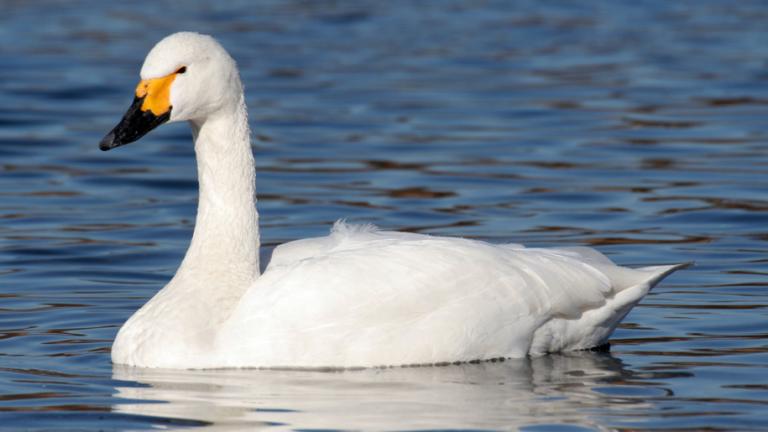
Spring is a very exciting season for Maryland birders. Beginning in late March, migratory songbirds arrive from southern wintering grounds, and birds that winter with us take flight for breeding grounds to the north. Each sunrise brings the promise of new morning bird song filling the air as our spring migrants begin their ancient courtship rituals.
Many of North America’s migratory warblers, vireos, flycatchers, thrushes and tanagers spend most of their year in the Caribbean, Mexico, and the Americas south of the U.S. They arrive here to nest and raise young in spring and summer. Some nest with us in Maryland, while others migrate through the state to breed in the northeastern U.S. and Canada.
You might wonder why a tiny warbler would leave the tropics to breed and raise young in Maryland when there is so much life south of the border. The answer lies in the incredible abundance of food that migratory songbirds need to raise their babies here, such as spiders, caterpillars and other insects.
Maryland’s deep, dark forests and cypress swamps are like a giant, never-ending buffet for birds, and they have more daylight here for feeding in the spring and summer than they do near the equator. When that abundant food disappears and the days begin to shorten in the fall, these same birds and their young fly south to survive the winter.
In Western Maryland, birders can experience morning birdsong in our hemlock and maple forests with the birds of Appalachia, such as Blackburnian, Canada and Cerulean Warblers. In Southern Maryland, forests and wet woods are filled with songs of the melodious Wood Thrush, while Kentucky and Hooded Warblers flit in the understory. In the Bald Cypress swamps of the Eastern Shore, the Louisiana Waterthrush can be spotted skulking along the water’s edge, while brilliant yellow Prothonotary Warblers sing from the cypress knees.
Altogether, more than 100 different species of songbirds can be tallied in Maryland’s springtime forests. Grab your binoculars and a strong cup of joe from a local coffee shop and experience spring sunrise birding in the Free State.
Suggested viewing locations: New Germany State Park, Chapman State Park, Pocomoke River State Park, C&O Canal
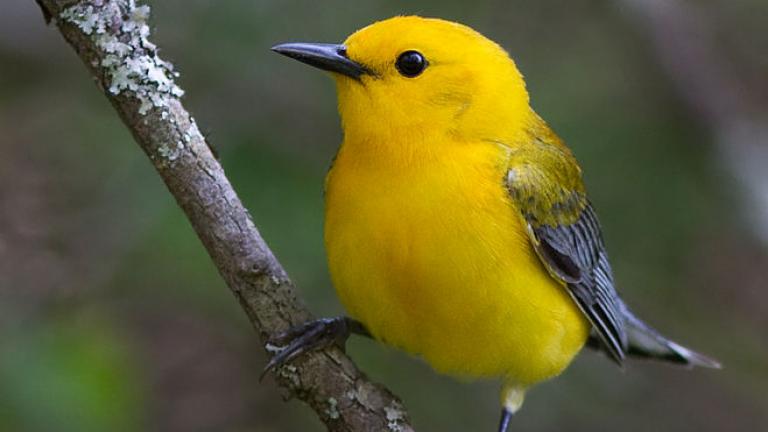
Any time you find thousands of wild birds feeding or gathered together in one place, you're bound to find birders watching from the sidelines with binoculars and cameras. Maryland mudflats, shallow ponds and beaches are teeming with life each spring when hungry shorebirds descend from the skies to feast and fatten up on their long journey to breeding grounds in the North.
Shorebirds are small to medium-sized birds that prefer to feed along beaches and tidal mudflats, fresh and saltwater wetlands, and open prairies and grasslands. Their bodies feature slender, pointed bills for probing in the sand, mud and soil, and long skinny legs for wading in shallow water.
Most of our shorebird species migrate through the state in the spring and again in late summer and fall when they travel south for the winter. Our migratory shorebirds include several species of sandpiper, plover, curlew and dowitcher, as well as Ruddy Turnstone, American Avocet, Whimbrel and Red Knot. A few species breed and raise young through the summer, including Willets, American Oystercatchers, Black-necked Stilts, Killdeer and the state Endangered Piping Plover. More than 40 species migrate through or breed in Maryland.
Both migrant and breeding shorebirds can be discovered feeding together in massive flocks in shallow ponds and on mudflats and sandy shorelines at low tide. The exposed wet soils host a smorgasbord of marine worms, small crustaceans, insects and the tiny energy-rich eggs of invertebrates, such as Horseshoe Crabs.
This bounty of food provides the fuel needed to propel shorebirds north to their breeding territories or to sustain our local breeding birds as they court, nest and raise young. Over the course of just two weeks, some migratory shorebirds can double their weight, adding 10 percent more mass during each day of feasting.
Along Maryland’s Atlantic coast, hotspots such as Assateague Island and Skimmer Island are perfect for finding migratory species such as the rare Red Knot, as well as breeding Willets, American Oystercatchers and Piping Plovers. Along the Chesapeake, state agencies and conservation organizations have restored incredible shorebird habitat at sites such as Poplar Island, Hart-Miller Island and Swan Creek Wetlands. Our Chesapeake beaches and inland shallow ponds are also great places to scope for shorebirds.
When viewing migratory and nesting shorebirds, it is important for birders and photographers to observe posted closure signs and respect boundaries established to protect the birds. Many areas are closed in the spring and summer months to allow birds to nest and feed safely.
Suggested viewing locations: Assateague Island National Seashore, Skimmer Island, Poplar Island, Hart-Miller Island, Swan Creek Wetlands
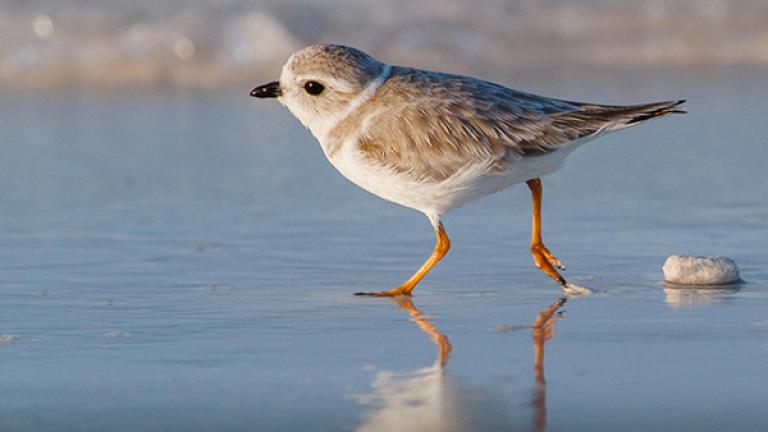
It’s pretty obvious that Maryland wildlife watchers will travel from the mountains to the beach to view and photograph our diverse bounty of birds, but many fans of the feathered will go to great lengths for the chance just to hear some of our most elusive nocturnal species.
While urban and suburban dwellers are likely familiar with the “hoo hoo hoooo” of the Great Horned Owl, and possibly the soft whinny and tremolo of an Eastern Screech-Owl, only those who travel to Maryland’s wilder regions will be rewarded with the nighttime noises of marsh-dwelling rails and the haunting whistles of the Chuck-will’s-widow and Eastern Whip-poor-will in our forests.
Rails are shy, secretive marsh birds, and most are about the size of a small chicken. They have short wings and tails, and big feet with long toes. Rails are rarely seen; they are experts at remaining hidden among the grasses and reeds in salt and freshwater marshes. Six species can be found in Maryland, from the fairly common Virginia Rail to the exceedingly rare Black Rail.
Chuck-will’s-widows are found mostly in forests of Southern Maryland and the Eastern Shore, while Eastern Whip-poor-wills are more abundant in the deep, dark mountain woods of Western Maryland. Both species are nocturnal and very well camouflaged, with tiny beaks that open giant, gaping mouths used to gobble up flying insects at night.
Traveling to a Maryland marsh to hear rails is unlike most other outdoor experiences. Rail enthusiasts will usually travel at twilight along a scenic rural road through the marsh, or enjoy a short night hike on a raised wetland boardwalk in a park or refuge. As the evening light fades, so goes your vision. Simultaneously, your hearing becomes more acute, and you begin to notice the sounds of nature all around you -- frog songs, insect buzzes, and the wind in the distant trees. If you’re in rail territory, you’ll soon hear the accelerating grunts and “kidik” sounds of these elusive marsh birds.
The songs of Chuck-will’s-widows and Whip-poor-wills are the sounds of summer camping in the Maryland woods. Usually about the time that the campfire is crackling and the marshmallows are roasting, you’ll hear these birds sing their names from the dark forest over and over again through the night, especially if the moon is out.
These nocturnal birding experiences are quite memorable and among the favorites of many Maryland birders.
Suggested viewing locations: for rails - Truitt’s Landing, Elliott Island, Jug Bay Wetlands Sanctuary; for Chuck-will’s Widows - Chesapeake Forest (N. Tara Road); for Whip-poor-wills - Green Ridge State Forest

Marylanders love summer on our Chesapeake and Atlantic coastal bays, and so do our terns, gulls and skimmers! Summertime vacationers and waterbirds have much in common. Most have migrated great distances to spend time in our warm coastal waters, and we all enjoy resting and relaxing on our sandy beaches. Fresh fish appeal to both tern and tourist, too.
Many of Maryland’s summer terns, gulls and skimmers nest in large, tightly-packed colonies on islands in the Chesapeake and coastal bays. Some even nest on flat rooftops near the water and abandoned barges! The islands are usually free from land-based predators, such as foxes, raccoons and feral cats. In addition, any predator that might be prowling about is faced with a large number of individuals, so there is some safety in numbers for the birds. The surrounding waters provide excellent fishing for feeding baby birds and hungry parents.
Most of these islands and nesting colonies are remote, but several can be viewed with binoculars and scopes from bridges and nearby shorelines. Many are closed to public access from April through September to protect nesting birds. Trespassing people and dogs can be incredibly dangerous to the colonies, as camouflaged eggs can be stepped on and crushed, and baby birds abandoned by frightened parents can suffer quickly in the hot sun.
While you may not get the chance to see nesting waterbirds up close, the parents and immature birds are quite visible and noisy on Maryland’s bays and rivers. In Ocean City, you’ll see and hear screeching Common, Forster’s and Royal Terns as they hover, swoop and dive right above the bridges that connect the resort to mainland Maryland.
On the world-famous Ocean City boardwalk, you’ll need to protect your French fries and ice cream from marauding bands of Laughing Gulls (note: please do not feed Maryland wildlife, including our gulls!).
One of the truly amazing spectacles you might witness in Maryland’s coastal bays is that of Black Skimmers feeding on small fish on the open water. The skimmer's large red and black bill is as thin as a steak knife, and the lower part of the bill is longer than the upper. When skimming for small fish, the bird glides in a straight line with just its lower bill slicing the water. When it touches a fish, the upper bill snaps down in the blink of an eye, thus securing the skimmer's dinner.
Crossing the Chesapeake Bay Bridge and other Maryland bridges in the summer, you may spot Great Black-backed Gulls, Herring Gulls, and Least Terns. If you are boating in the bay and get too close to a nesting colony, you’ll be scolded by raucous parents and warned to back off. In Baltimore, you can find Common and Least Terns feeding on the Patapsco River at Fort McHenry.
This summer, it’s your “tern” to experience Maryland’s colonial nesting birds in the Chesapeake and coastal bays!
Suggested viewing locations: Sunset Park, Sandy Point State Park, Fort McHenry National Monument and Historic Shrine, Point Lookout State Park
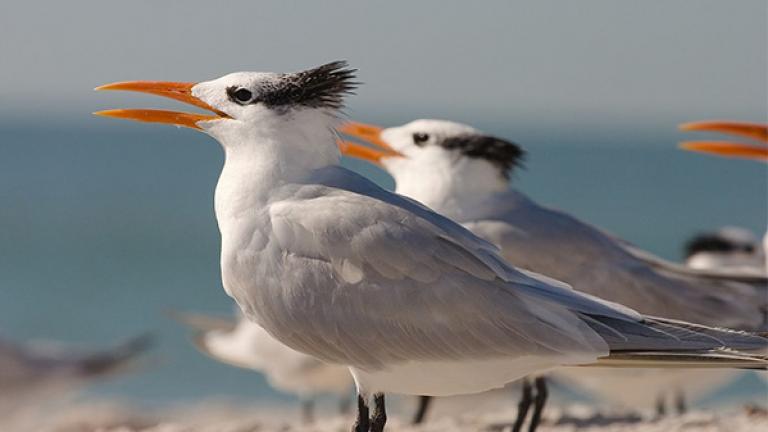
When visiting Maryland’s Chesapeake and Atlantic coastal bays in early summer, birders are likely to discover a few Brown Pelicans flying and feeding near our beach and bay towns and wildlife refuges. You’ll also find several species of wading birds -- our herons, egrets and ibis -- feeding in marshes along the Chesapeake and behind Assateague Island.
When you visit the same coastal communities in July and August, the populations of these birds appear to have boomed overnight. In late summer, great trailing lines of Brown Pelicans can be seen soaring at sunset over the beaches of Ocean City and Assateague, and near the bayside villages of Crisfield, Solomons Island and Hoopers Island. Herons, egrets and ibis of all colors and sizes have also dramatically increased their numbers, much to the delight of the birders and wildlife photographers.
This late summer spectacle can largely be attributed to the post-breeding dispersal of pelicans and wading birds that nest in colonies on islands throughout the heart of the Chesapeake Bay and the coastal bays. After successfully raising fuzzy baby birds on a healthy diet of fish and crustaceans, the immature birds feather out and take flight. Soon, they begin exploring Maryland with their parents before most head south in the autumn, much to the delight of birders, boaters and beachgoers.
Among the species you’ll discover in Maryland are large Great Blue Herons, which tend to nest in small colonies at the tops of tall trees near the water. These birds can be seen year-round. Migratory species range from white Great and Snowy Egrets, to colorful Tricolored, Little Blue and Green Herons. Glossy Ibis can be seen feeding in the marshes of the Chesapeake and coastal bays. In recent years, flocks of White Ibis can be found on Assateague Island in the summer months.
Brown Pelicans are another fairly recent addition to the list of Maryland’s breeding birds. Based upon their absence in state historic and fossil records, pelicans are not known to have nested in Maryland prior to 1987. That year, the first record of Brown Pelicans breeding in Maryland was noted on Tizzard Island in Chincoteague Bay. Today, thousands of Brown Pelicans nest between Smith Island and Holland Island, the furthest north these birds currently nest and raise young on the East Coast.
If you want to experience some of the best pelican and wading bird watching in Maryland’s Chesapeake Bay, plan a trip to Smith Island. Known worldwide for its working boats, fishing villages, delicious crabs and Smith Island cake (Maryland’s official state dessert!), the Free State’s only inhabited island is quickly becoming a favorite destination for viewing and photographing herons, egrets, ibis and Brown Pelicans.
Suggested viewing locations: Smith Island, Janes Island State Park, Point Lookout State Park, Hooper’s Island, Assateague Island National Seashore
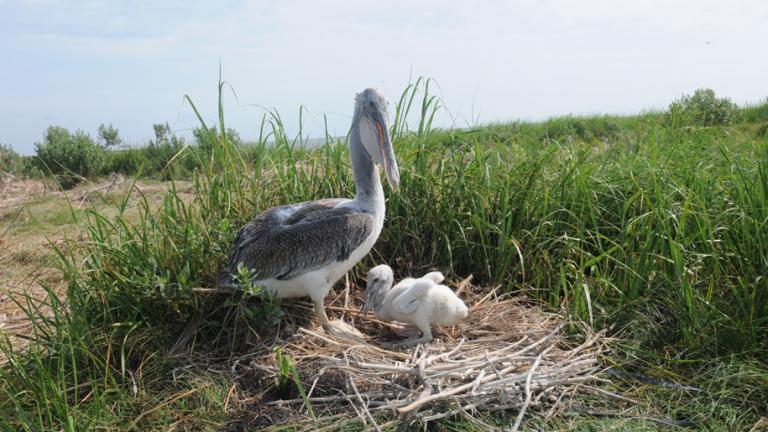
As the long, sunny days of summer get shorter and fade into the cool nights of early autumn, thousands of migrating raptors will travel south through Maryland on their way to their wintering grounds in the southern U.S. and Central and South America. This is the time of year for fans of these charismatic birds of prey to pack their binoculars and spotting scopes and head to one of Maryland's magnificent hawk watching sites.
Raptors are the group of birds that includes hawks, falcons, eagles, and ospreys, and are known for hunting and feeding on other animals. Vultures, known more for eating carrion, are also included in this group. The term "raptor" is derived from the Latin word rapere, meaning to seize or take by force. Strong grasping feet equipped with sharp talons, a hooked upper beak, and excellent binocular vision characterize these avian predators.
At our hawkwatches, visitors are welcome to witness the autumn raptor spectacle live and in person. Some of the birds of prey flying overhead include several species of hawks, including Red-tailed, Red-shouldered, Broad-winged, Cooper’s, and Sharp-shinned Hawks; Bald and Golden Eagles, Turkey and Black Vultures, Kestrels, Merlins and Peregrine Falcons.
View the “Atlantic Flyway in person or online at the Washington Monument in Boonsboro: The spine of South Mountain is known as the “Atlantic Flyway” and is the pathway for neotropical migrating birds when travelling to/from warmer climates, such as hawks, eagles and owls! Washington Monument State Park has an official Hawk Watching station, recognized by the Hawk Migration Association of North America, or HMANA
At many hawkwatches, volunteers count the birds and report their totals to the Hawk Migration Association of North America (www.hawkcount.org). The data collected in Maryland are critical to understanding raptor populations, and assessing their needs so that vulnerable populations can be protected.
The best time to visit one of Maryland's hawkwatches is mid-morning to mid-afternoon after a cold front has passed through. The northwest winds provide a strong tailwind for migrating raptors and drive many birds south.
Before migrating, raptors need to bulk up by adding up to 20 percent of their body weight in fat, which becomes high-powered migration fuel. Larger species with broad wings, such as eagles, vultures and large hawks, conserve energy by taking advantage of updrafts and thermals when migrating up to 300 miles each day. They are rarely seen flapping their wings when they appear over Maryland's hawkwatch sites. A group of these circling raptors is referred to as a "kettle" when they ascend quickly to thousands of feet in the air, and then glide down in the direction of their destination. Smaller hawks, falcons, and ospreys migrate by soaring and employing more active, flapping flight during migration. These species will hunt in the early morning or late afternoon to fuel their journey south.
Put on your favorite fall fleece or sweater, grab a cup of joe from a local coffee shop, and visit one of our hawkwatches to witness the rivers of raptors in Maryland's skies.
Suggested viewing locations: Cumberland Gap, Fort Smallwood Park (really good spring hawk watching, too!), Elk Neck State Park - Turkey Point, Maryland Hawkwatch sites from the Hawk Migration Association of North America.
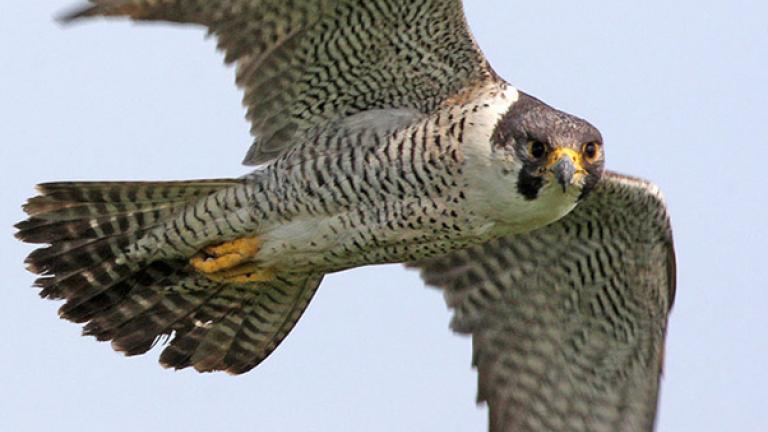
Maryland is an exciting state to witness a true wonder of the wild world -- the miracle of fall migration. Overnight, relatively quiet parks and natural areas can be transformed into bustling, open aviaries, with songbirds dripping from every tree branch and twig. Species not seen since the spring make their annual autumn appearance as they push south to warmer wintering grounds.
Fall migration actually starts in early summer for some shorebirds, but August, September and October are peak months for most songbirds and raptors. Typically, big, soaring birds, such as hawks and egrets, migrate during the day when they can take advantage of thermals and air currents that provide lift under their large wings to assist them on their journey south.
Smaller songbirds, such as warblers, thrushes and flycatchers, tend to migrate at night. After a long night flight, the little birds will spend the morning foraging on fruits, seeds and insects to get their energy up for the next leg of their trip. While feeding, you can get nice looks at these birds, who seem much more concerned about breakfast than any threat posed by a quiet, patient birder.
During fall migration, cold fronts pushing through Maryland can produce migratory bird "fallouts," when thousands of birds leave the skies to congregate in a small area while waiting for better weather. Some fallout sites can be small, such as a green urban park, while others occur in large tracts of forest along peninsulas in the Chesapeake and Atlantic coastal bays.
If strong winds blow from the south, many migrant songbirds will wait for days until favorable tail winds appear to help carry them southward once again. Strong storms and high winds can cause birds to fly a little too far over the Atlantic, and these cautious migrants will make their way back towards the Maryland coast, where they can wait safely for the bad weather to pass.
Watch the forecast and get outside after the cool autumn winds start to blow, and you might experience your own fall migration fallout in Maryland!
Suggested viewing locations: Assateague Island National Seashore - Bayside Point, Patterson Park, Point Lookout State Park

Get Your Free Guide to Birding in Maryland
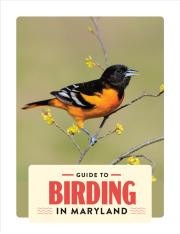
Make like Maryland's iconic brown pelicans and take a deeper dive into Maryland's birding scene with our free Guide to Birding in Maryland. With maps, seasonal info, and insights into how to spot some of the Old Line State's hardest-to-find feathery friends, it's a must for beginners and seasoned birders alike. And did we mention it's free?





